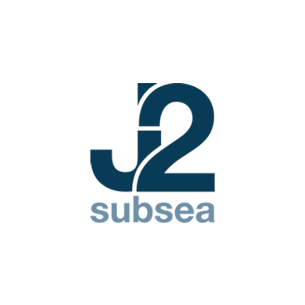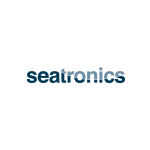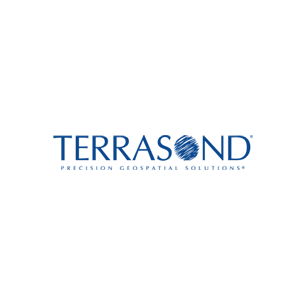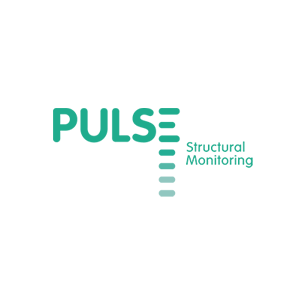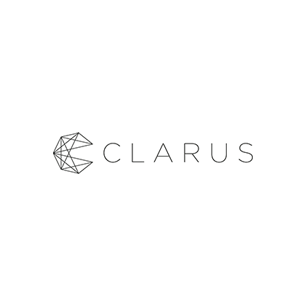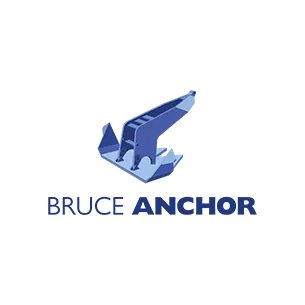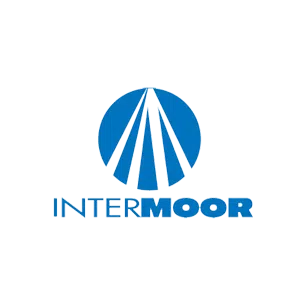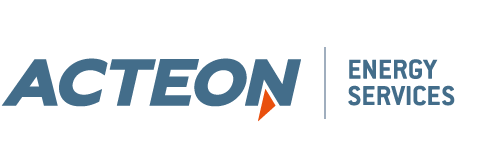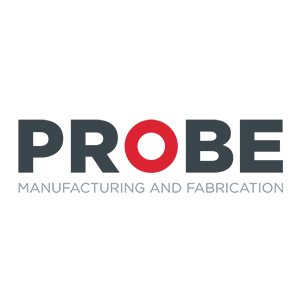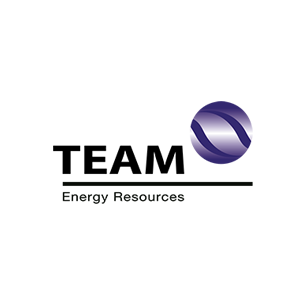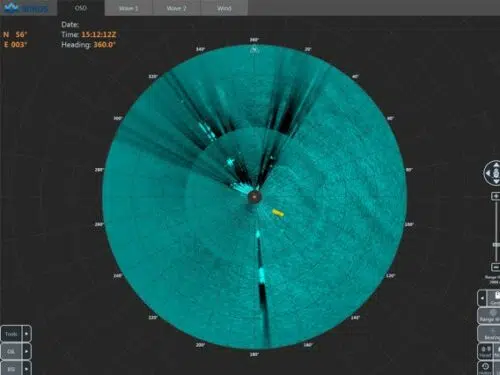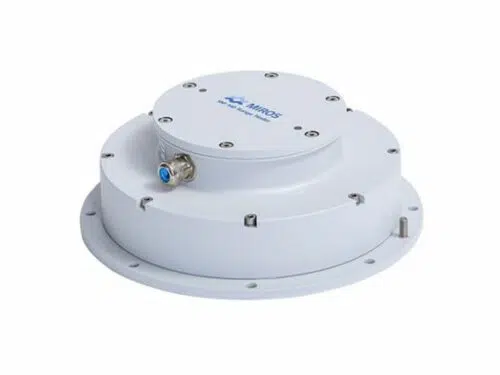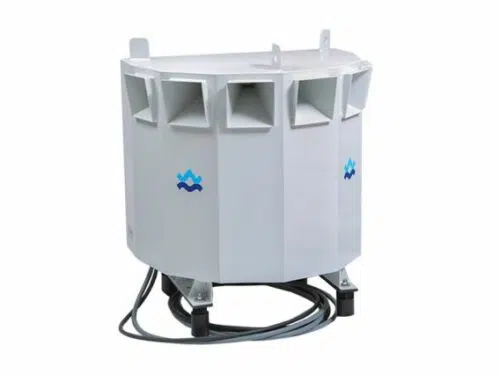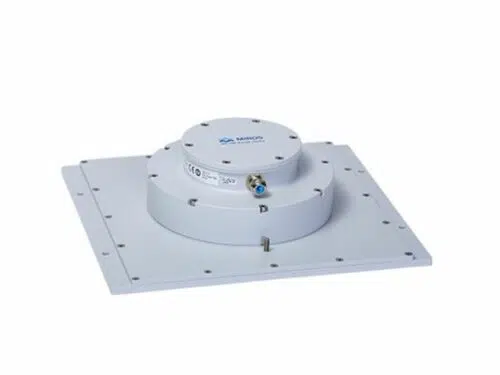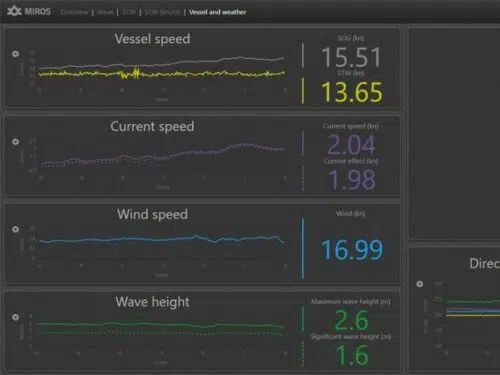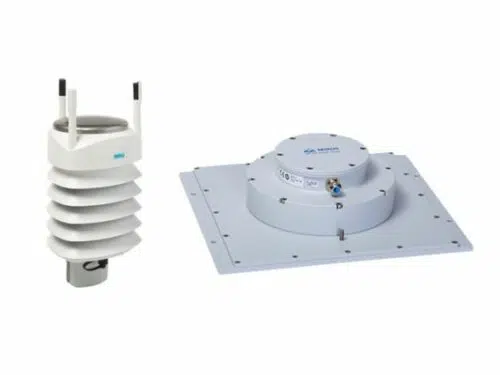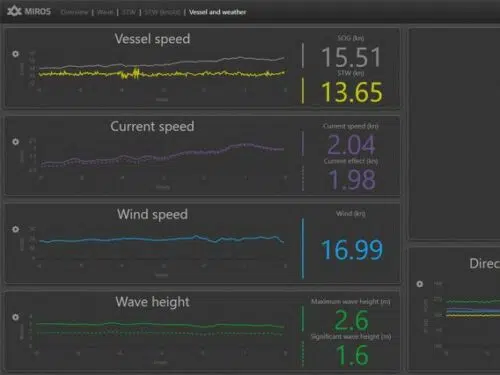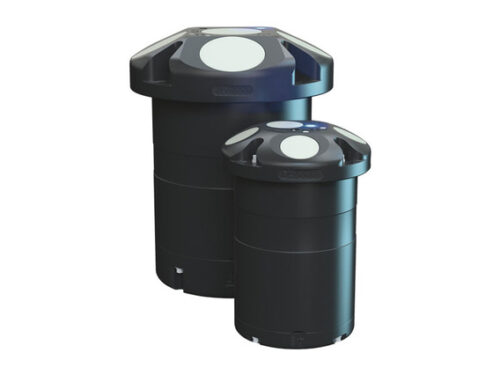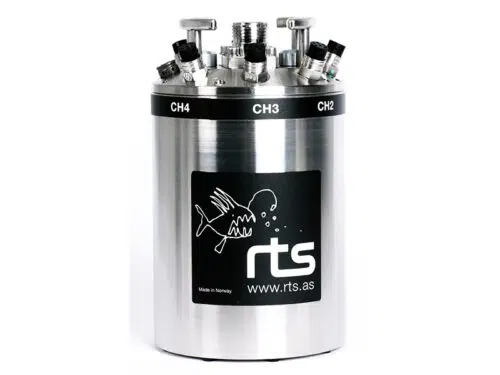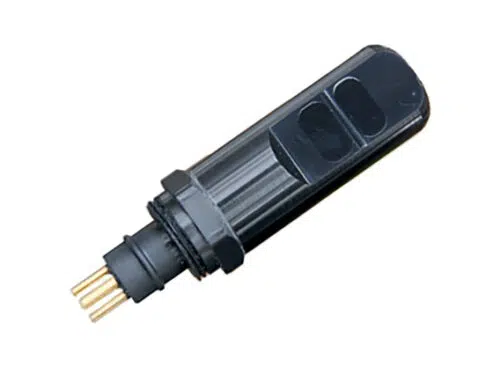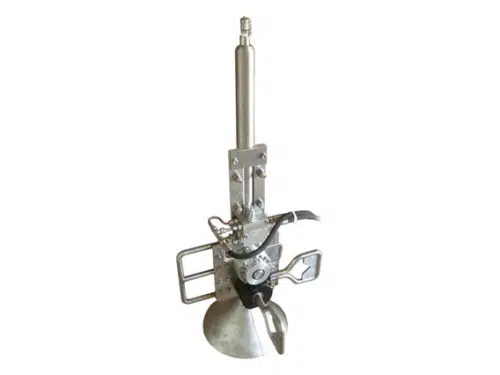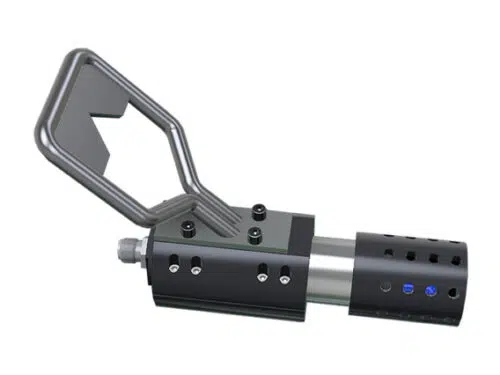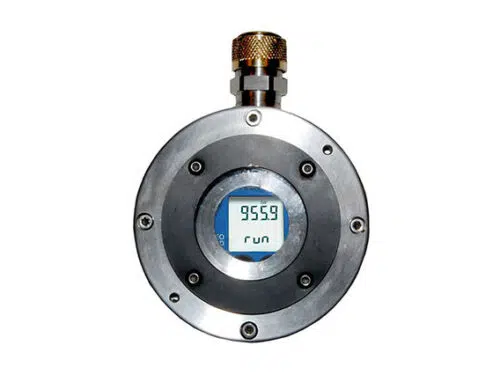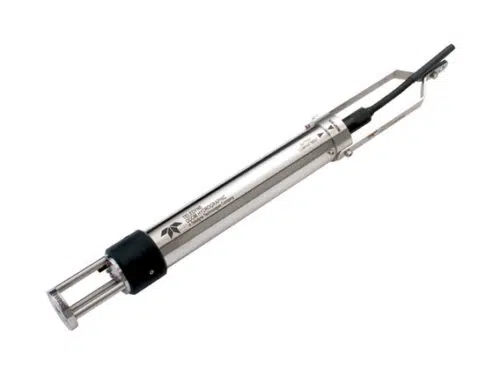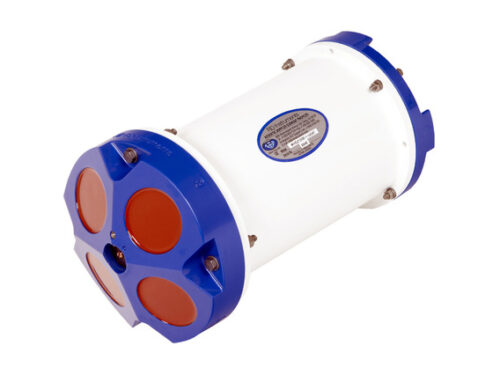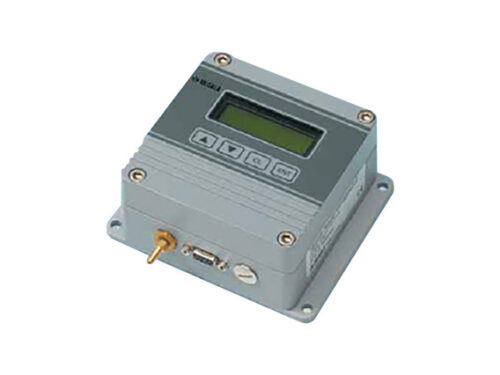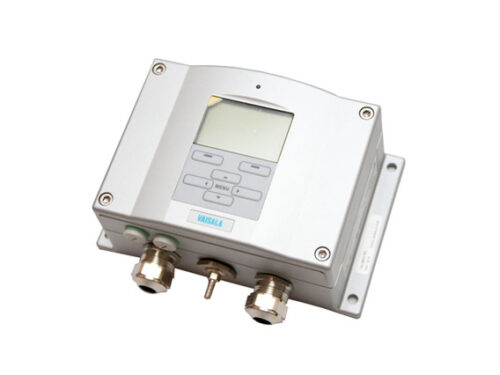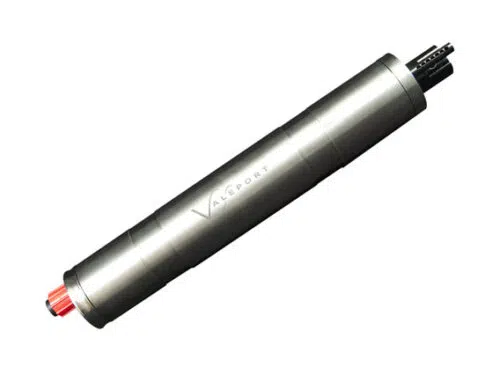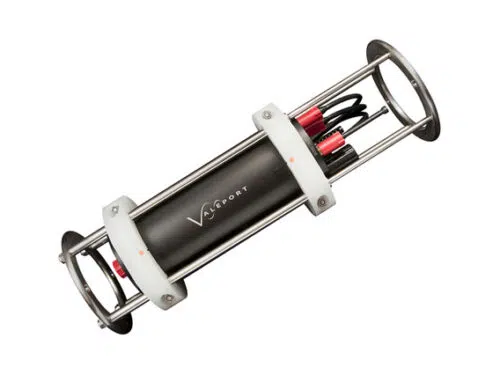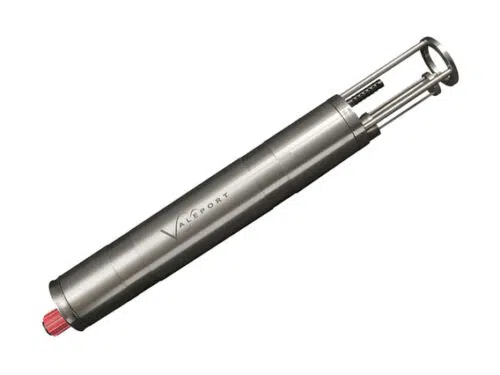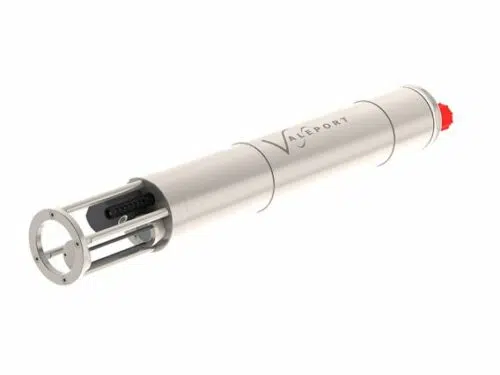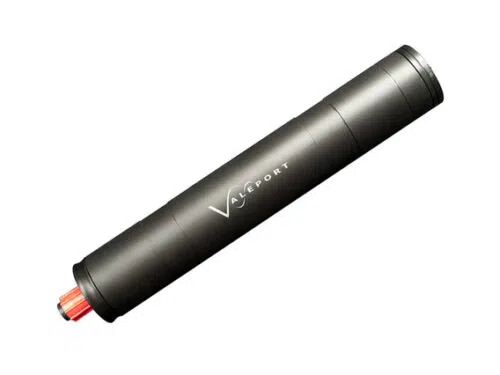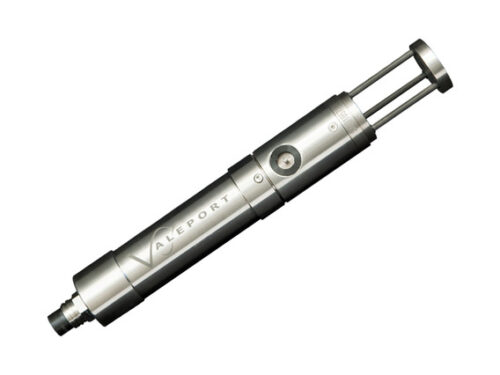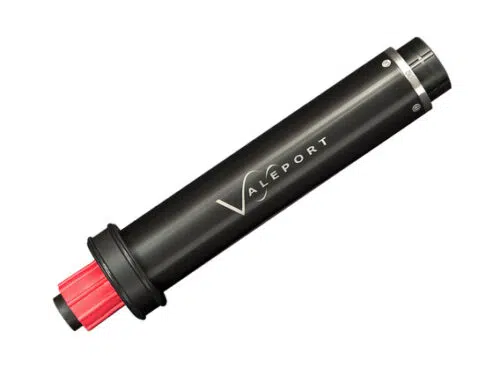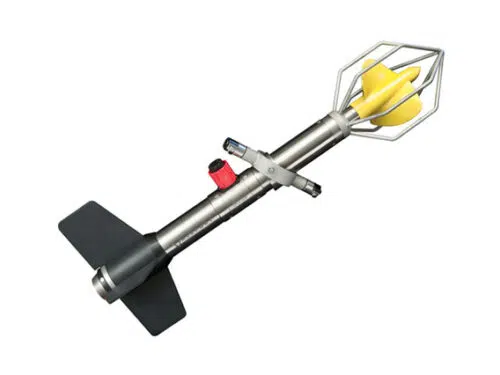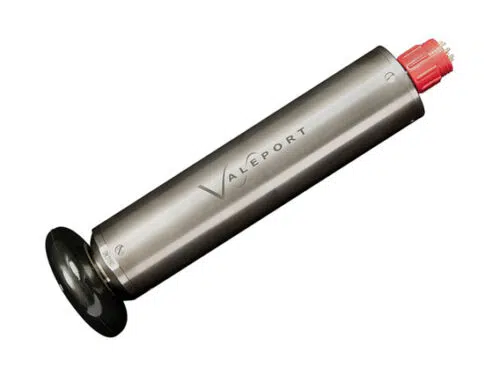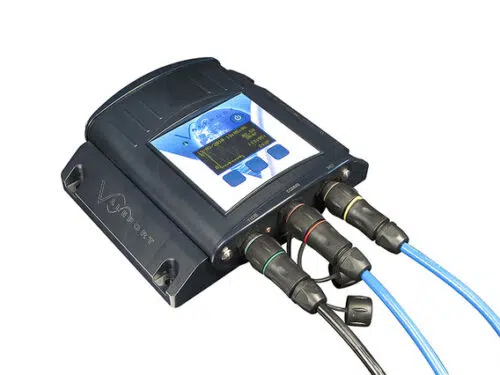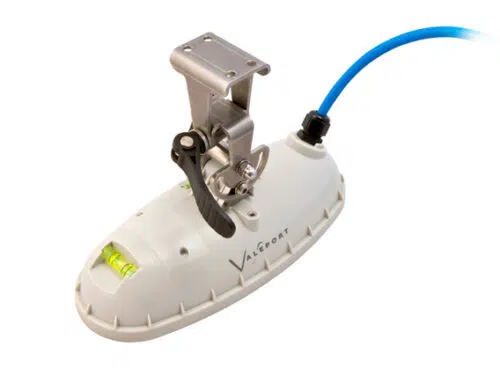Environmental
Return to HydrographicSearch products
X Products selected
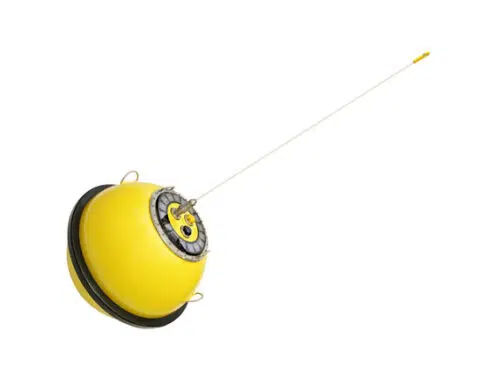
The Directional Waverider hardly needs any introduction: it is the world’s standard for measuring wave height and wave direction. Its success is due to the proprietary well-proven and accurate Datawell stabilized platform sensor, enabling wave height measurements by a single accelerometer. For the wave direction, direct pitch and roll measurements are performed needing no integration. In combination with horizontal accelerometers and a compass this forms the complete sensor unit, the heart of the instrument.
- Real time measurement of wave height with half hourly heave and directional spectra updates.
- HF link up to 50 km over sea. The proprietary Datawell HF link module is easy replaceable if a different transmission frequency is required.
- LED flash light integrated in the top of the antenna increasing the buoy’s visibility.
- GPS receiver for buoy positioning has now become a standard feature of the DWR-MkIII, and facilitates its retrieval.
- Integrated data logger based on the latest flash card technology.
- A water temperature sensor in the mooring eye providing sea surface temperature
- High capacity primary cells operating reliably and safely under all wave conditions and weather circumstances for up to three years without replacement.
- Built-in energy meter reports an accurate estimation of the remaining operating life.
RX – C Receiver
The RX-C is a dedicated HF link receiver that supports all Datawell Waverider buoys fitted with the standard HF transmitter.
In the RX-C, a programmable digital frequency synthesizer makes it possible to manually select the reception frequency in 100 Hz steps.
This allows reception of any frequency between 25.5 and 35.5 MHz by the touch of a button.
RX – D Receiver
The RX-D is a dedicated HF link receiver that supports all Datawell Waverider buoys fitted with the standard HF transmitter.
The RX-D is tuned to a single frequency by a crystal. The crystal can be custom made to allow reception of any frequency between 25.5 and 35.5 MHz. The receiver is normally tuned at the factory but can be retuned later by Datawell to allow reception of other frequencies.
The RX-D is especially designed for single buoy applications or for use on fixed receiving locations where the reception frequency does not have to be changed often.
Miros Oil Spill Detection (OSD) is optimized for both oil spill surveillance and oil spill response delivered as a dual-mode system. Miros OSD is thoroughly verified in oil-on-water exercises and used by major oil operators and authorities around the world.
The OSD Surveillance mode is designed to provide automatic alarms and situational awareness when an oil spill appears on the ocean surface. The system automatically detects oil spills and shows them alongside AIS targets and IR/daylight camera views. Offshore installations and vessels, as well as coastal and port sites, are given early warning capabilities, where data is provided to support response decisions and planning.
Miros OSD in Recovery mode will guide the response vessel towards the part of the oil slick where the highest recovery efficiency is obtained. The thicker part of the oil slick is identified with support of IR and visible spectrum sensors, aiding correct positioning of booms, skimmers and dispersant application.
- Automatic detection with high detection rate and low false alarm rate, day & night
- Up to 8 cameras with 2 video streams each,
- Up to 2 X-band radars
- Historical data with playback mode
- Camera tracking of detections, AIS targets and drift buoys
- Oil drift prediction, AIS targets, wind, current, wave and ice data
The versatile SM-140 RangeFinder is purpose made for accurate measurements of the vertical distance to the water surface, and with market leading range and accuracy specifications. The measurements are not impacted by fog, rain or water-spray. The sensor is available with two antenna alternatives, either a 10° wide or 5° narrow beam width antenna with a smaller footprint, to suit different applications. Measurement ranges from 1 – 23 m to 2 – 95 m. The sensor is also available in an Ex approved version.
- High sampling rate and accuracy
- Embedded data processing and browser-based user interface
- IoT enabled for easy data access, locally and remotely
- No parts submerged in water
- Low maintenance cost
The sensor provides accurate air gap data at high sampling rates. Water Level and Draught are calculated, where averaging periods and reference points are configurable. Wave variables are calculated both from the wave spectrum and from timeseries.
The SM-140 RangeFinder is a stand-alone sensor with embedded processing and storage, enabling data to be easily and securely accessible both locally and remotely by utilizing modern IoT technologies.
The sensor has proved its ruggedness and reliability through many years of service in extreme weather conditions, all over the world.
The SM-050 Wave and Current Radar is a unique high-performance remote sensor for measurement of directional wave spectra and surface current. It is the only sensor which utilizes dual-footprint pulse Doppler method for wave measurements, and microwave dual frequency method for measuring surface currents.
The sensor provides excellent quality wave-spectrum and -parameter data. The accuracy of which has been verified in a number of independent comparisons.
The SM-050 enables data to be easily and securely accessible both locally and remotely by utilizing modern IoT technologies.
The sensor has proved its ruggedness and reliability through years of service in extreme weather conditions, including heavy precipitation, all over the world.
- Embedded data processing and WEB-server
- Easy data access, locally and remotely
- No parts submerged in water
- High reliability
- Low maintenance cost
- For fixed and floating installation
The new SM-140 WaveFinderTM is purpose made for accurate wave-measurements from vessels and floating installations. It is based on the SM-140 RangeFinder and its market-leading range and accuracy specifications, complemented with an integral high-precision motion reference unit.
- Embedded data processing and browser-based user interface
- IoT enabled for easy data access, locally and remotely
- Easy to install
- No parts submerged in water
- Low maintenance cost
The 5° narrow-beam antenna gives a small footprint on the sea surface, enabling the sensor to measure shorter wave-periods from a longer distance than sensors with 10° antennas. Wave variables are calculated both from timeseries data and from the wave spectrum. The sensor is available in an Ex approved version.
The SM-140 WaveFinder is a stand-alone sensor with embedded processing and storage, enabling data to be easily and securely accessible both locally and remotely by utilizing modern IoT technologies.
It is compact and easy to install. Only a network connection and power are required. The narrow beam antenna enables a more flexible installation alongside the hull.
The sensor has proved its ruggedness and reliability through many years of service in extreme weather conditions, all over the world.
Our WaveSystems are designed to provide accurate wave, current and draught data for weather critical marine operations. The system also provides real time positive or negative draught, depending on whether the hull is partly below or above the water line.
The system provides data both during transit and when stationary, utilizing the higher accuracy data provided by the RangeFinder or WaveFinder when possible, typically below 4 knots. These sensors also provide measured Hmax calculated from the time series.
As Miros sensors are completely dry, with no parts submerged into water, they benefit from much more efficient and simpler installation and maintenance procedures compared to wave buoys.
- Real-time sea state and draught monitoring
- Directional wave and surface current data
- Data export to third party systems
- No parts submerged in water
- Low maintenance costs
The compact and easy to install Miros WaveWeather is designed to deliver accurate, real-time measurements of the local sea and weather conditions to any user on any device.
- Real-time monitoring of wave, water level and weather data
- Easy data access anywhere
- No parts submerged in water
- Low maintenance cost
The system comprises a Miros RangeFinder and a Vaisala Weather Transmitter. The compact Weather Transmitter provides wind, temperature, humidity and pressure data utilizing the unique Vaisala solid state technology. The RangeFinder accurately measures the vertical distance to the sea-surface, undisturbed by fog, rain or water-spray. The sensor provides accurate air-gap, and calculated water level and draught data where averaging periods and reference points are configurable. Wave variables are calculated both from the wave spectrum and from timeseries.
Data is integrated into the Miros Cloud, making it immediately accessibility anywhere, without the need for any external processing. Miros Cloud enables easy integration with tidal tables, weather forecasts and other relevant data sources.
The sensors have proved their ruggedness and reliability through many years of service in extreme weather conditions, all over the world.
Wavex® captures and processes sea surface backscatter data from a standard X-band marine navigation radar. Through robust, accurate and adaptive algorithms it calculates directional wave, surface current and speed through water (STW) data. Measurements are made in a relevant area of the waterbody, unaffected by the vessel itself.
Wavex now provides easy and secure data access, both locally and remotely, by utilising modern IoT technologies – view and analyse real-time and historical data anytime, anywhere, on any device.
- Real-time directional wave measurements
- Real-time surface current measurements
- Real-time STW measurements
- Operates at any ship speed
- No calibration required
- No parts submerged in water
- Low maintenance costs
- Integrates with third-party systems
- IoT-enabled & Cloud-integrated
- Access data locally & remotely
Nortek’s Signature1000 and Signature500 five-beam AD2CPs introduce a scientific powerhouse to the research community, providing an ideal platform for turbulence studies and Ice drift measurements, while also fulfilling standard current profiling needs. They are multipurpose broadband instruments offering great benefits in areas that could not be covered with existing ADCP’s.
- 16 Hz – faster sampling than with any other ADCP
- Provide four times the information as previous instruments sampling at 4Hz
- 5 beams – more data and information
- Allows for turbulence measurement and ice measurement capabilities
- Flexibility in Data collection. Multiple measurement modes.
- One instrument replaces several by offering concurrent or alternating measurements of currents, turbulence, waves and ice.
- Records all raw data
- Improve data quality by removing contamination from fish or other influences.
- Lightweight and Low power usage
- Nearly neutral buoyancy in water. 50% longer deployment time.
- NORTEK Blue light
- Ever wondered if your instrument has started? The NORTEK blue light will tell you
The RTS SiLOG is compact high specification data logger tailor-made for subsea applications. Based on years of experience with a host of different subsea sensors, the RTS Development team has engineered a versatile unit which can not only collect and provide safe data storage subsea, it also offers sensor control through different comms options and deep-sleep functionality for long-term logging applications.
- Multiple subsea sensor logging
- Multiple comms options
- Software controlled
- Sensor diagnostics
- PoE (Power Over Ethernet)
- Deep-sleep functionality
- Titanium housing
The Seapoint Turbidity Meter detects light scattered by particles suspended in water, generating an output voltage proportional to turbidity or suspended solids.
The low power requirements make it ideal for applications where battery drain is a concern. Range is selected by two digital lines which can be hard wired or microprocessor controlled, thereby choosing the appropriate range and resolution for measurement of extremely clean to very turbid waters. The offset voltage is within 1 mV of zero and requires no adjustment across gains. The unique optical design confines the sensing volume to within 5 cm of the sensor allowing near-bottom measurements and minimizing errant reflections in restricted spaces. The sensor is easily interfaced with data acquisition packages; a 5 ft pigtail is supplied. Custom configurations are available.
- Very low power requirements
- Small size
- 6000 m depth capability
- Optically confined sensing volume
- Insensitive to ambient light
- Linear output over more than 5 decades
- Four programmable ranges
- Optical feedback compensates for temperature coefficient and aging of optical components
- Very low power requirements
- Very low offset voltage does not require adjustment
- Interfaces easily with data acquisition systems
- Rugged, corrosion-free materials
- Pin compatible with Seapoint Chlorophyll Fluorometer and
- Seapoint Rhodamine Fluorometer
The Specialist Offshore Services gas sampling unit combines several safety features to allow users to operate with unknown gases. The sample bottle is rated to 5000 PSI, which allows users to bring samples back from depths as great as 3000MSW. All outlets from the bottle have 2 barriers to protect users.
The hydraulically operated valve ensures that at least one valve cannot be accidentally left slightly open by error or accident. The manual valve is operated by the ROV 7 function manipulator and forms the last barrier on the collection side to protect users. The sample point allows for easy gas extraction and testing without having to use the ROV operated valves.
- Sample Bottle NACE and DOT compliant
- All valves NACE compliant
- 1 hydraulically closed valve, 1 Manually closed ROV valve as standard. Options available on request, such as dual hydraulic valves, or dual ROV manual valves
- 2 barriers of protection from sample bottle, sample side and collection side.
- Separate sample point for easy extraction
- 5 Function and 7 Function manipulator handles
- Standard size 500ml,however custom versions available on request.
- Weight 14kg in air, 12kg in seawater
- Height 970mm x Width x 500mm x Depth 300mm
Specialist Offshore Services Pty Ltd PH probe allows the in situ determination of pH up to a pressure of 600bar, or 6000MSW. The PH sensor is an inner gel electrolyte filled glass tip, with a small hole to allow the measurement of the PH of the unknown solution. This provides a stabilised junction potential allowing a fast response, and accurate measurement. New version has separate optional Temperature probe.
The glass transducer gives long life and minimal re-calibration. The software allows for easy calibration before ROV deployment, as well as an ASCII serial output to interface with typical video overlay systems, meaning the PH can be recorded on screen.
Software provides logging ability, to an ASCII formatted file, for easy importation into popular software packages.
- Operating Depth : up to 6000 MSW
- Measuring principle: potentiometric
- pH Sensor: Glass Membrane
- Temperature Sensor : Ag/AgCl double bridge
- Measuring range: defaults to 3..11 pH
- Expanded range selectable 0..14pH
- Accuracy: pH 0.03
- Redox +/- 10m
- Resolution: 0.01 pH
- Time Constant: t63% < 3s
- Temperature range: -2.. +38 degrees C
- Requires: 0V, 24V, RS232 Tx/Rx/Common
- Probe housing: AISI 316L
- pHSensor body: titanium
- Probe Diameter: 48.5mm
The core of the system is a digital pressure and temperature logger, built into a stainless steel pressure housing with viewing window, suitable for immersion to 4000 metres of seawater. Then assembled with ROV Operable valves and client specified hotstab / connection arrangement. (Frame is customizable)
The core of the system is a digital pressure and temperature logger, built into a stainless steel pressure housing with viewing window, suitable for immersion to 4000 metres of seawater. Then assembled with ROV Operable valves and client specified hotstab / connection arrangement. (Frame is customizable)
The Data logger, range 0 to 700bar, up to 57,000 readings, 0.1% accuracy, resolution 100mBar. Can be certified ATEX approved for intrinsic safety. It is supplied with Logger windows software for logger setup and downloading of data.
Data can be viewed in table or graph format and exported to MS Excel.
- High measuring accuracy, resolution and robustness
- High data security due to the use of a non-volatile memory
- Temperature Measurements Accuracy typ. 0,5 °C
- Recording of the pressure and temperature
- Simple and well-structured configuration- and read-out software for PC
- Combination of event-controlled recording and interval recording prevents unnecessary data being recorded (i.e. only measuring the pressure changes…)
- Supply 3,6 V Lithium battery
- Battery Life up to 2 years @ 1 recording every 10 seconds
- Subsea housing dimensions 165mm long x 105mm diameter, weight 5.5 Kg
The rugged all stainless steel Digibar S was designed for un-tethered sound velocity casting. This configuration frees the probe from its electrical cable making deeper sound speed profiling a much easier and more reliable task.
- Rugged, stainless steel construction
- 500 meter maximum depth
- Records sound velocity, temperature, pressure and time
- Simple Windows based interface
With a 500 m maximum depth capability and storage for multiple casts, the “S’s” flexible design still maintains some of the best features of the popular Digibar Pro. Immediately before the unit is deployed, a simple system of flashing LEDs serves to confirm battery status, pressure sensor status, and overall probe operation. The confirming indicators drastically reduce the possibility of retrieving a deployment only to find that there is no data to show for the effort. Logging parameters are setup via a simple Windows interface communicating through your PC’s USB port. That same port is used to download the results of the cast and to charge the probe’s internal batteries. Cast data (sound velocity, temperature, pressure, and time) are stored internal to the probe in EEPROM. This means that critical measurements are maintained independently from the batteries that power the unit’s time of flight velocity determining circuitry, thereby providing an extra layer of security for the all-important cast results. Accurate, easy to use, rugged and reliable all appropriate descriptors of the Digibar S and the hallmark of Teledyne Odom’s product lines.
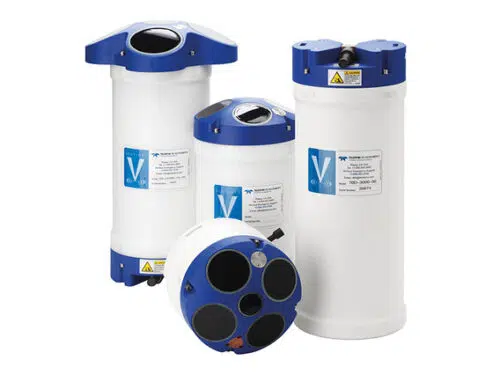
The self-contained Sentinel V is the first in a series of exciting, next-gen Acoustic Doppler Current Profilers (ADCPs) to be released by Teledyne RD Instruments. Building upon the unparalleled success of our Workhorse ADCP products, our next generation V products offer a new level of features and versatility.
With profiling ranges from <1m to >150m and a 200m depth rating, the Sentinel V ADCP is ideally suited for a wide variety of coastal applications.
The lightweight and adaptable Sentinel V is easily deployed on buoys or mounted on the seafloor. Real-time data can be transmitted to shore via a cable link or acoustic modem, or data can be stored internally for short or long-term deployments. With a pressure sensor delivered standard in Sentinel V, this highly versatile tool can be easily upgraded via an electronic firmware update to calculate directional and non-directional wave parameters.
- Multiple simultaneous sampling strategies
- High-speed wireless data download
- Record every measurement
- 5 beams for data redundancy and enhanced measurements
- Off-the-shelf battery option
- Increased Portability
- Single digit start up
- Uninterrupted data collection
- Replaceable transducer pucks
- Flood resistant electronics chamber
The self-contained Sentinel is Teledyne RD Instruments’ most popular and versatile Acoustic Doppler Current Profiler (ADCP) configuration, boasting thousands of units in operation in over 50 countries around the world.
- Versatility: Direct reading or self contained, moored or moving, the Sentinel provides precision current profiling data when and where you need it most.
- A solid upgrade path: The Sentinel has been designed to grow with your needs. Easy upgrades include pressure, bottom tracking, and directional wave measurement.
- Precision data: Teledyne RDI’s patented BroadBand signal processing delivers very low-noise data, resulting in unparalleled data resolution and minimal power consumption.
- A four-beam solution: Teledyne RDI’s patented 4-beam design improves data reliability by providing a redundant data source in the case of a blocked or damaged beam; improves data quality by delivering an independent measure known as error velocity; and improves data accuracy by reducing variance in your data.
By providing profiling ranges from 1 to 165m, the high-frequency Sentinel ADCP is ideally suited for a wide variety of applications. The Sentinel also offers unbeatable precision, with unmatched low power consumption, allowing you to collect more data over an extended period.
The lightweight and adaptable Sentinel is easily deployed on buoys, boats, or mounted on the seafloor. Real-time data can be transmitted to shore via a cable link or acoustic modem, or data can be stored internally for short or long-term deployments. The Sentinel is easily upgraded to include pressure, bottom tracking, and/or directional wave measurement—for the ultimate data collection solution.
Vaisala BAROCAP® Digital Barometer PTB220 is designed for measurements in a wide environmental pressure and temperature range. The barometers are ideal to be used e.g. as ship barometers, as transfer standards in weather stations and as replacements for mercury barometers.
- 500…1100 hPa or 50…1100 hPa pressure ranges
- -40…+60 °C (-40.+140 °F) operating temperature range
- Total accuracy ±0.15 hPa (class A)
- Long-term stability ±0.1hPa/yr (500…1100 hPa)
- Several output options
- Available with one, two, or three barometric pressure transducers
- NIST traceable (certificate included)
The PTB220 barometers feature extremely high accuracy. Class A barometers are fine adjusted and calibrated against a deadweight tester. Class B barometers are adjusted and calibrated using electronic working standards. All PTB220 barometers are delivered with a factory calibration certificate, which is NIST traceable.
A single barometer can have one, two or three pressure transducers. Two or three transducers provide redundancy, which improves measurement reliability in airport, weather station and pressure standard applications.
The local display has two rows and it can simultaneously show the barometric pressure, three-hour pressure trend and WMO pressure tendency code.
The PTB220 barometers use the in house developed Vaisala BAROCAP® Sensor. This silicon capacitive absolute pressure sensor has excellent hysteresis and repeatability characteristics, and outstanding temperature and long-term stability.
Vaisala BAROCAP® Digital Barometer PTB330 is a new generation barometer, designed for a wide range of high-end atmospheric pressure measurement.
- Vaisala BAROCAP® sensor
- Accurate measurement
- Excellent long-term stability
- Added reliability through redundancy
- Graphical trend display with 1-year history data
- Altitude corrected pressure (QFE, QNH)
- For professional use in meteorology, aviation, laboratories, and demanding industrial applications
The MIDAS CTD (previously known as the Model 606) is Valeport’s premier CTD Profiler. High accuracy sensors (including ±0.01% pressure) and robust titanium design allow reliable operation to 6000m depth, under the harshest conditions
It also features truly synchronised sampling to ensure that all sensors are sampled at exactly the same point during a profile. Primarily for use as a self recording profiler, the MIDAS CTD also has a range of communications options for real time use, and the low power consumption and large memory also make it suitable for longer term deployments.
The MIDAS CTD+ is a revolutionary Multiparameter CTD, with a wide choice of standard sensors.
Featuring Valeport’s latest 400 Series electronics, the CTD+ will sample all fitted sensors at exactly the same instant, at up to 8Hz. Advanced setup software allows a variety of sampling regimes including burst modes, delay starts, and conditional sampling.
With up to 64Mbyte memory and internal battery pack, as well as a selection of real time output formats, the CTD+ is perfect for both profiling or fixed mooring applications. In addition, the CTD+ may be used with Valeport own water bottle carousel.
The MIDAS SVP is the new name for Valeport’s renowned Model 650 Mk2 Sound Velocity Profiler, and it gives the most accurate Sound Velocity Profiles currently possible.
As well as using the world leading digital time of flight sound speed sensor, this instrument also has a ±0.01% pressure sensor, and features Valeport’s synchronised sampling technique to guarantee that all sensors are sampled at exactly the same point during a profile. Titanium construction and a large memory make it suitable for rapid profiling down to 6000m depth.
The MIDAS SVX2 is the latest version of Valeport’s unique instrument. Recognising the conflict faced by users requiring the superior Sound Velocity data from an SVP, but still needing the Salinity and Density data from a CTD, the MIDAS SVX2 combines both technologies to give the best of both worlds.
Now fitted with a 0.01% pressure sensor as standard, the SVX2 also uses synchronised sampling to ensure perfect profiles, and since the digital time of flight SV sensor is the most accurate in the world, it’s also possible to compare the true sound velocity data with that generated by commonly used equations.
The MIDAS WLR replaces the popular Model 730T as Valeport’s Water Level Recorder / Seabed Tide Gauge.
Designed for long or short term deployments in offshore environments, or locations where a traditional shore based tide gauge is impractical, the MIDAS WLR may be moored in line or to the seabed. The standard instrument is fitted with a 0.01% accuracy pressure sensor and acetal housing for up to 500m depth rating, with a deep water titanium housed option also available.
The miniSVS Sound Velocity Sensors use state of the art digital “time of flight” technology to provide the lowest noise, highest accuracy, best resolution sound velocity data available.
Small size and a choice of sensor lengths down to just 25mm make the sensor suitable for a variety of applications, and the optional pressure or temperature sensor adds versatility. There is a choice of data formats to allow interface to existing systems. We will also consider OEM and custom designs.
The miniTIDE is a small Tide Recorder, designed for short term underwater deployments.
Fitted with a 0.01% temperature compensated piezo-resistive cell, the miniTIDE will record high accuracy pressure data for a period of 1 month at a 10 minute sampling interval, using a single alkaline C cell. This makes it ideal for use in short term projects or for academic studies. Available with a choice of pressure ranges, and with either 500m acetal or 6000m titanuim housings.
A low cost, lightweight alternative to larger flow meters, ideal for use in applications where the superior durability and depth rating of Valeport’s larger meters is not necessary.
Utilising the standard Valeport 125mm diameter impeller, the Model 106 features speed and direction parameters as standard, with further options of temperature and depth. Data (logged or real time) is compatible with Valeport’s DataLog™ software.
The instrument is manufactured from titanium and polymers, giving excellent resistance to corrosion, whilst maintaining a small size and low weight. These features make the Model 106 the ideal instrument for coastal and estuarine applications, and other light duty survey work.
The Model 803 is designed specifically for use on ROVs and other underwater vehicles, providing real time relative water velocity information for pilots.
It may be fitted to ROVs to provide actual through the water speeds, or fitted to Tether Management Systems to give measurement of local flow conditions. Measurements are updated every second and the ROVLog™ software provides a graphic and data display, and enables data to be logged to disk.
The TideMaster is a small, cost effective Water Level Recorder, specifically designed for applications where the user requires an accurate record of water height, but with the added option of meteorological data via a ultrasonic wind speed and direction sensor.
Suitable for use in fresh or salt water, the TideMaster can be deployed for up to 1 year, dependant on the sampling rate, with instrument set up and data retrieval via an optional display panel or using the PC software supplied. Alternatively, the system can be supplied with radio modules for real time data transmission.
The VRS-20 is a pulsed k-band radar level sensor developed by Valeport to work seamlessly with the TideMaster tide logger, operate standalone with optional integrated GPRS telemetry or interface to a third party data logger.
Versatile and simple to install, the VRS-20 addresses a number of the issues traditionally associated with water level measurement. Non-contact technology removes the installation, corrosion & fouling issues of submerged sensors, while simplifying datum control. Accuracy and performance are unaffected by changes in water density and atmospheric conditions.

